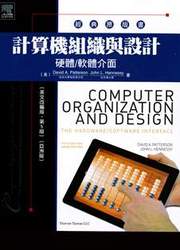Reuse Methodology Manual for System-On-A-Chip Designs, 3/e (Hardcover)
Michael Keating, Pierre Bricaud
- 出版商: Kluwer Academic Publ
- 出版日期: 2002-06-30
- 售價: $1,500
- 貴賓價: 9.8 折 $1,470
- 語言: 英文
- 頁數: 292
- 裝訂: Hardcover
- ISBN: 1402071418
- ISBN-13: 9781402071416
立即出貨 (庫存=1)
買這商品的人也買了...
-
 Computer Organization & Design: The Hardware/Software Interface, 2/e
Computer Organization & Design: The Hardware/Software Interface, 2/e$1,200$1,176 -
 計算機組織與設計--軟硬體界面第二版 (Computer Organization & Design, 2/e)
計算機組織與設計--軟硬體界面第二版 (Computer Organization & Design, 2/e)$680$537 -
 C++ Primer, 3/e 中文版
C++ Primer, 3/e 中文版$980$774 -
 $970Introduction to Algorithms, 2/e
$970Introduction to Algorithms, 2/e -
 Digital Image Processing, 2/e(IE)(美國版ISBN:0201180758)
Digital Image Processing, 2/e(IE)(美國版ISBN:0201180758)$1,150$1,127 -
 Thinking in Java 中文版 (Thinking in Java, 2/e)
Thinking in Java 中文版 (Thinking in Java, 2/e)$920$727 -
 LPI Linux 資格檢定 (LPI Linux Certification in a Nutshell)
LPI Linux 資格檢定 (LPI Linux Certification in a Nutshell)$880$695 -
 $1,029Operating System Concepts, 6/e (Windows XP Update)
$1,029Operating System Concepts, 6/e (Windows XP Update) -
 鳥哥的 Linux 私房菜
鳥哥的 Linux 私房菜$560$476 -
 JavaScript 範例活用辭典
JavaScript 範例活用辭典$450$351 -
 Understanding the Linux Kernel, 2/e (Paperback)
Understanding the Linux Kernel, 2/e (Paperback)$1,900$1,805 -
 C++ Builder 6 完全攻略
C++ Builder 6 完全攻略$690$587 -
 作業系統概念 (Operating System Concepts, 6/e Windows XP Update)
作業系統概念 (Operating System Concepts, 6/e Windows XP Update)$780$741 -
 Java 完美經典優質學習篇
Java 完美經典優質學習篇$750$638 -
 Red Hat Linux 9 實務應用
Red Hat Linux 9 實務應用$650$514 -
 ASP.NET 程式設計徹底研究
ASP.NET 程式設計徹底研究$590$466 -
 Windows Server 2003 網路與 IIS 架站指南
Windows Server 2003 網路與 IIS 架站指南$680$537 -
 STRUTS 實作手冊(Struts in Action: Building Web Applications with the Leading Java Framework)
STRUTS 實作手冊(Struts in Action: Building Web Applications with the Leading Java Framework)$690$538 -
 重構─改善既有程式的設計
重構─改善既有程式的設計$720$569 -
 Practical Java Programming Language Guide 中文版 (Practical Java Programming Language Guide)
Practical Java Programming Language Guide 中文版 (Practical Java Programming Language Guide)$560$442 -
 How the Internet Works, 7/e
How the Internet Works, 7/e$1,360$1,292 -
 鳥哥的 Linux 私房菜-伺服器架設篇
鳥哥的 Linux 私房菜-伺服器架設篇$750$638 -
 鳥哥的 Linux 私房菜─基礎學習篇增訂版
鳥哥的 Linux 私房菜─基礎學習篇增訂版$560$476 -
 Java 2 完美的演繹
Java 2 完美的演繹$550$468 -
 $1,078Operating System Principles, 7/e(IE) (美國版ISBN:0471694665-Operating System Concepts, 7/e) (平裝)
$1,078Operating System Principles, 7/e(IE) (美國版ISBN:0471694665-Operating System Concepts, 7/e) (平裝)
商品描述
Reuse Methodology Manual for System-on-a-Chip Designs, Third Edition outlines a set of best practices for creating reusable designs for use in an SoC design methodology. These practices are based on the authors' experience in developing reusable designs, as well as the experience of design teams in many companies around the world. Silicon and tool technologies move so quickly that many of the details of design-for-reuse will undoubtedly continue to evolve over time. But the fundamental aspects of the methodology described in this book have become widely adopted and are likely to form the foundation of chip design for some time to come.
Development methodology necessarily differs between system designers and processor designers, as well as between DSP developers and chipset developers. However, there is a common set of problems facing everyone who is designing complex chips.
In response to these problems, design teams have adopted a block-based design approach that emphasizes design reuse. Reusing macros (sometimes called "cores") that have already been designed and verified helps to address all of the problems above. However, in adopting reuse-based design, design teams have run into a significant problem. Reusing blocks that have not been explicitly designed for reuse has often provided little or no benefit to the team. The effort to integrate a pre-existing block into new designs can become prohibitively high, if the block does not provide the right views, the right documentation, and the right functionality.
From this experience, design teams have realized that reuse-based design requires an explicit methodology for developing reusable macros that are easy to integrate into SoC designs. This manual focuses on describing these techniques. Features of the Third Edition:
- Up to date;
- State of the art;
- Reuse as a solution for circuit designers;
- A chronicle of "best practices";
- All chapters updated and revised;
- Generic guidelines - non tool specific;
- Emphasis on hard IP and physical design.






























